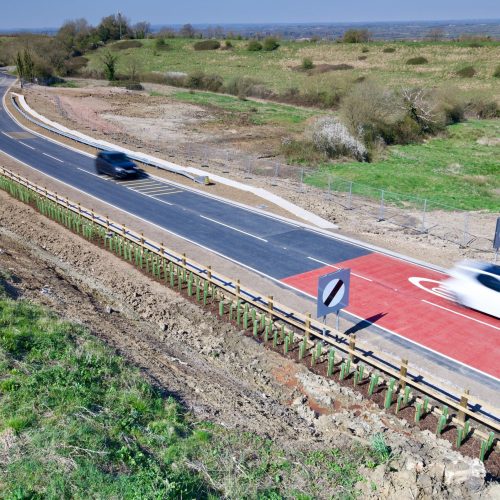Closed following a major landslip in 2022, the B4069 at Lyneham Banks, Wiltshire, is now open to traffic once more. Delivered to schedule and budget, work to reinstate and future proof the road was completed by Octavius Infrastructure.
The project restores a major transport route which, prior to the landslip carried more than 5,500 vehicles each weekday. Communities will be reconnected and lengthy diversions brought to an end. What was once described as ‘England’s wonkiest road’, is back in service.
“This was a challenge. About 90 metres of carriageway was lost. The hillside was still creeping when we commenced work, tackling such ground conditions demanded some creative solutions,” said Chris Hudson, Operations Director of Octavius’ highways business, “But we are about bringing people together, so it was great to help reconnect communities affected by this lengthy road closure.”
The landslip, which dislodged about 90 metres (m) of carriageway and transported it 40m down the hillside, was probably due to a combination of historic weaknesses, increased groundwater flows, and additional loading due to nearby development.
Measures to restore the carriageway, and mitigate future subsidence, included a 108m-long contiguous bored pile retaining wall adjacent to the westbound carriageway, which was reconstructed on the original alignment. The wall comprises 120 reinforced concrete bored piles installed below a 1.5m-high capping beam.
The slope above and below the roadway was regraded, and drainage systems installed beneath the new carriageway and on the hillside above and beneath. Work to restore and protect the carriageway cost £5 million.
The poor ground conditions that contributed to the road collapse also hampered the remedial work. It was not possible to clear out and replace the unstable ground, the ideal approach. Instead the ground had to be compacted sequentially, in nine separate ten-metre bays along the line of carriageway, a slower more incremental way of working. Buried obstructions were common throughout the route, often necessitating deeper excavations to ensure piling integrity.
As with the carriageway work the drainage programme was fragmented due to the ground conditions. Only after the installation of initial drains allowed the ground to begin to dry out was it possible to revisit an area and lay the full drainage system. Sitting on a rural B road limited access to the site, restricting the ability to undertake multiple activities simultaneously, which reinforced the linear, sequential nature of the way the location and ground conditions shaped the delivery of the project.
Media enquiries to media@octavius.co.uk


